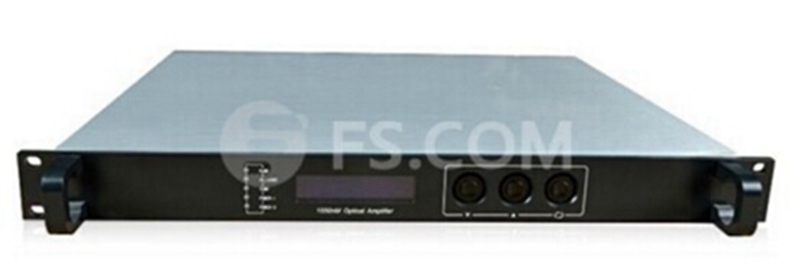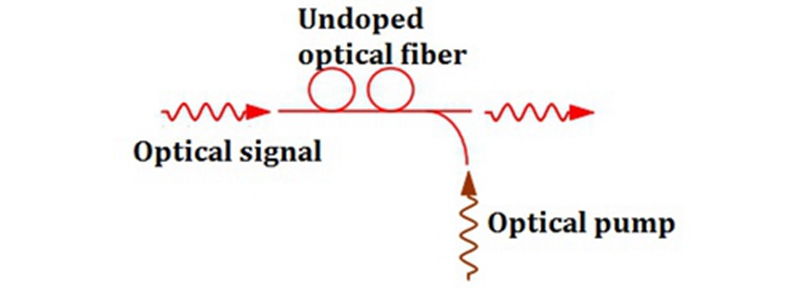In comparison with the long-haul DWDM network that uses the thermo-electric coolers to stabilize the laser emissions essential, the CWDM network is a more economical solution that features wider wavelength spacing, allowing the wavelength fluctuation of uncooled directly modulated laser diodes (DMLs). But on the other hand, the CWDM network exists the limitation for the uncooled DMLs’ output power and the additional loss of CWDM Mux Demux and optical add/drop modules. These make the CWDM loss budget limited to < 30 dB and the CWDM reach within 80 km. Moreover, when the insertion loss of the dark fiber is higher than our expectation, a decreasing transmission distance may occur. Hence, here offers the Raman amplifier (see the following figure) to extend the CWDM network reach, as an ideal solution.
What’s Raman Amplifier?
Raman amplifier, also referred to as RA, is a kind of optical fiber amplifier based on Raman gain, which is used for boosting optical signals and finally achieving a longer transmission distance. Different from the erbium-doped fiber amplifier (EDFA) and semiconductor optical amplifier (SOA), the RA intensifies the signals through the nonlinear interaction between the signal and a pump laser within an optical fiber, as shown in the figure below.
At present, two kinds of Raman amplifiers are available on the market, the distributed and lumped Raman amplifiers. As for the distributed Raman amplifier (DRA), it uses the optical fiber as the gain medium to multiplex the pump wavelength with signal wavelength, so that the optical signals can be boosted. With regard to the lumped one (LRA), it requires a shorter length of optical fiber for the signal amplification. Both of these two Raman amplifiers are suitable for amplifying CWDM signals and extending the CWDM network reach.
Why Raman Amplifier Is Used for Amplifying CWDM Signals?
As we know, the EDFA and SOA are able to strengthen the CWDM signals. But why it is not recommendable for the CWDM network? In fact, they can not perform as well as the RA in the CWDM network for some limitations, which can be learned from the following figure.
The figures above shows various gain bandwidths of these three optical fiber amplifiers for CWDM network, but only the gain bandwidth the RA offers meet the CWDM network demands. To fully serve the CWDM network, the RA usually optimizes the pumping lightwave spectrum to extend the usable optical bandwidth. As for the EDFA, its gain bandwidth can not match well with the channel spacing of the CWDM network requirements. And for the SOA, although it offers the gain bandwidth fit enough for the CWDM network, it is still not suggested for the inherent technical limitations. In details, the SOA has a relatively low saturation power but a high noise figure and polarization sensitivity, compared to other two amplifiers. Hence, the RA is undoubtedly the best choice to strengthen the CWDM signals and lengthen the CWDM network reach.
How Does Raman Amplifier Benefit CWDM Network?
In order to study the benefit of RA for the CWDM network, here offers two sets of research data about the receiver sensitivity, for a bit-error rate (BER) of 10-9 using a pseudo-random bit sequence (PRBS) with a 231-1 word length.
From the figure above, we can learn that the first set of data is resulted from the four channel CWDM network without use of the RA, while the second utilizes the RA. In order to check whether the Raman amplifier benefits the CWDM network, we can take the data of 100km CWDM transmission through singlemode fiber (SMF) as an example. The power penalty of the transmission with a RA are separately -34.4 dBm, -34.2 dBm, -33.2 dBm and -32.3 dBm. It is 0.3 dBm better than the power penalty of the transmission without a RA, at least. Except that, we can also learn that the CWDM network with a RA can transmit the signals through the SMF at lengths up to 150m without any repeater stations, while the network without the RA cannot.
Conclusion
The Raman amplifier is an ideal alternative to the repeater in CWDM network, for intensifying the CWDM signals and extending the CWDM network reach. By using the Raman amplifier, the loss budget of the CWDM network can be increased, which finally achieves a longer transmission. Meanwhile, from the view of cost, the RA and the repeater are almost the same, but the repeater stations should cost much more for constructing and maintaining. Moreover, using the RA in the CWDM network can also gain the loss compensation of OADM. Then, why not use Raman amplifier to extend your CWDM network reach?




